
Waitangi Day, the national day of New Zealand, marks the anniversary of the initial signing – on 6 February 1840 – of the Treaty of Waitangi, which is regarded as the founding document of the nation. The first Waitangi Day was not celebrated until 1934, and it was made a national public holiday in 1974.

Hōne Wiremu Heke Pōkai, born Heke Pōkai and later often referred to as Hōne Heke, was a highly influential Māori rangatira (chief) of the Ngāpuhi iwi (tribe) and a war leader in northern New Zealand; he was affiliated with the Ngati Rahiri, Ngai Tawake, Ngati Tautahi, Te Matarahurahu and Te Uri-o-Hua hapū (subtribes) of Ngāpuhi. Hōne Heke fought with Hongi Hika, an earlier war leader of the Ngāpuhi, in the Musket Wars. Hōne Heke is considered the principal instigator of the Flagstaff War in 1845–46.
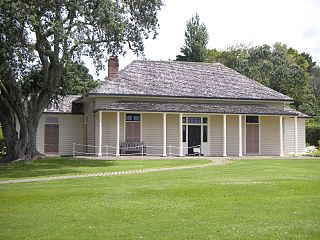
The Treaty House at Waitangi in Northland, New Zealand, is the former house of the British Resident in New Zealand, James Busby. The Treaty of Waitangi, the document that established the British Colony of New Zealand, was signed in the grounds of the Treaty House on 6 February 1840.
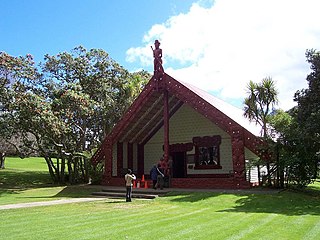
Waitangi is a locality in the Bay of Islands on the North Island of New Zealand. It is close to the town of Paihia, 60 kilometres north of Whangarei. "Waitangi" is a Māori-language name meaning "weeping waters".

Ngāpuhi is a Māori iwi associated with the Northland regions of New Zealand centred in the Hokianga, the Bay of Islands, and Whangārei.

Ngāti Whātua is a Māori iwi (tribe) of the lower Northland Peninsula of New Zealand's North Island. It comprises a confederation of four hapū (subtribes) interconnected both by ancestry and by association over time: Te Uri-o-Hau, Te Roroa, Te Taoū, and Ngāti Whātua-o-Ōrākei. The four hapū can act together or separately as independent tribes.
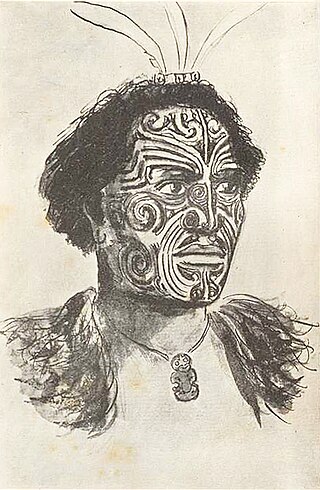
Hongi Hika was a New Zealand Māori rangatira (chief) and war leader of the iwi of Ngāpuhi. He was a pivotal figure in the early years of regular European contact and settlement in New Zealand. As one of the first Māori leaders to understand the advantages of European muskets in warfare, he used European weapons to overrun much of northern New Zealand in the early nineteenth century Musket Wars. He was however not only known for his military prowess; Hongi Hika encouraged Pākehā (European) settlement, built mutually beneficial relationships with New Zealand's first missionaries, introduced Māori to Western agriculture and helped put the Māori language into writing. He travelled to England and met King George IV. His military campaigns, along with the other Musket Wars, were one of the most important motivators for the British annexation of New Zealand and subsequent Treaty of Waitangi with Ngāpuhi and many other iwi.
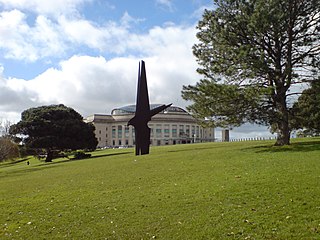
The Auckland Domain, also known as Pukekawa / Auckland Domain, is a large park in Auckland, New Zealand. It is the oldest park in the city, and at 75 hectares is one of the largest. Located in the central suburb of Grafton, the park land is the remains of the explosion crater and most of the surrounding tuff ring of the Pukekawa volcano.

Moutoa Gardens, also known as Pākaitore, is a park in the city of Whanganui, New Zealand. Named after the Battle of Moutoa Island in the Second Taranaki War, it contains a memorial to the battle inscribed "To the memory of the brave men who fell at Moutoa, 14 May 1864, in defence of law and order against fanaticism and barbarism." It also contained a statue of John Ballance, organiser of a volunteer cavalry troop in Tītokowaru's War and later Premier of New Zealand, but the statue was beheaded and a replacement installed outside the district council building. A number of items present in the park are registered by Heritage New Zealand.

The United Tribes of New Zealand was a confederation of Māori tribes based in the north of the North Island, existing legally from 1835 to 1840. It received diplomatic recognition from the United Kingdom, which shortly thereafter annexed it under the Treaty of Waitangi, an event that has largely shaped relations between the government of New Zealand and the Māori people since the 1960s.

Henry Williams was the leader of the Church Missionary Society (CMS) mission in New Zealand in the first half of the 19th century.
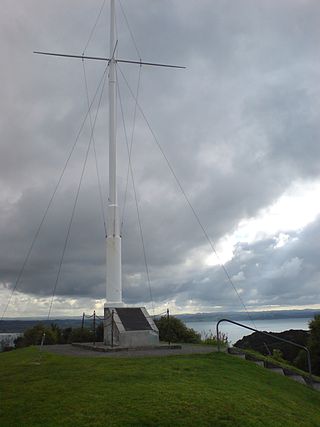
Flagstaff Hill overlooks the Bay of Islands, New Zealand. Directly north of the small historical village of Russell, the flagstaff on the hill played a significant role in early relations between the local Māori of the Ngāpuhi iwi and early British colonials.

Āpihai Te Kawau was a paramount chief of the Ngāti Whātua Māori iwi (tribe) of Auckland, New Zealand in the 19th century.

Titewhai Te Huia Hinewhare Harawira was a New Zealand Māori activist. Born in Whakapara and descended from Ngāpuhi chiefs, Harawira was an outspoken political commentator and a civil rights campaigner beginning with her involvement with activist group Ngā Tamatoa in the 1970s. She became a nationally recognised figure due in part to her role escorting New Zealand prime ministers onto the marae during annual Waitangi Day celebrations.
Edward Marsh Williams was a missionary, interpreter, and judge who played a significant role in the British colonisation of New Zealand. He was born in Hampstead, Middlesex, the eldest son of Archdeacon Henry Williams and Marianne Williams.

Ngāti Whātua Ōrākei or Ngāti Whātua-o-Ōrākei is an Auckland-based Māori hapū (sub-tribe) in New Zealand. Together with Te Uri-o-Hau, Te Roroa and Te Taoū, it comprises the iwi (tribe) of Ngāti Whātua. These four hapū can act together or separately as independent tribes. The hapū's rohe is mostly in Tāmaki Makaurau, the site of present-day Auckland. Ngāti Whātua Ōrākei has around 6,000 members whose collective affairs are managed by the Ngāti Whātua Ōrākei Trust.

Petone Settlers Museum is a local history museum located in the Wellington Provincial Centennial Memorial, a historic building in Petone, Lower Hutt, New Zealand. The building was originally constructed to mark the Wellington province's centennial commemorations; the museum opened in the building in 1977. The building was extensively refurbished in 2016.
Mana motuhake is a phrase in the Māori language that means self determination, with the principle being autonomy and control. It is sometimes translated to the concept of sovereignty.

Te Puea Memorial Marae is a marae located in Māngere Bridge, Auckland, New Zealand. Opened in 1965, it was the first urban marae in Auckland, built for ngā hau e whā, but in particular as a community centre for local Urban Māori communities around Onehunga and Māngere, and for the Waikato Tainui iwi. The marae is named for Māori leader and relative of King Mahuta, Te Puea Hērangi, and is known by the whakataukī (proverb) te kei o te waka o Tainui, as it is the northernmost Waikato Tainui marae.

Charles Frederick Baker was an English member of the Church Missionary Society (CMS) active as a missionary in New Zealand in the 19th century. He supervised the construction of the historic church at Russell and was involved in the Treaty of Waitangi proceedings, a collection consisting of his journals and papers was added to the UNESCO Memory of the World New Zealand register in 2018.



















